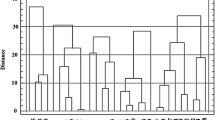Abstract
Boron (B) efficiency of oilseed rape (Brassica napus) and mustard (B. juncea) genotypes was determined on a low B soil at Mt. Compass, South Australia. B efficiency was observed in oilseed rape genotypes, Zhongyou 821, Dunkeld and Zheyou 2, and in mustard genotypes Pusa Bold and CSIRO 6. Genotypes grown in the field were also grown under glass-house conditions, in pots filled with pre-washed sand extracted from the Mt. Compass field site. Two B treatments, one B adequate (0.25 mg B kg−1 soil) and one B deficient (imposed by omission) were used to indicate whether vegetative response to B could predict final yield response and provide a more convenient selection criterion for identifying B-efficient germplasm. Vegetative response of 35 d old (D35) genotypes grown in pot culture closely reflected field response, indicating the expression of B efficiency traits in early growth, and its potential use in selection.
Similar content being viewed by others
References
Bagheri A, Paull J G, Rathjen A J, Ali S M and Moody D B 1992. Genetic variation in the response of pea (Pisum sativum L.) to high soil concentrations of boron. Plant Soil 146, 261-269.
Chantachume Y, Smith D, Hollamby G J, Paull J G and Rathjen A J 1995. Screening for boron tolerance in wheat (T. aestivum) by solution culture in filter paper. Plant Soil 177, 249-254.
GENSTAT Committee 1989. GENSTAT 5 reference manual. Clarendon Press. Oxford, UK.
Graham R D 1984. Breeding for nutritional characteristics in cereals. Adv. Plant Nutr. 1, 57-102.
Maud, R R 1972. Geology, geomorphology, and soils of central County Hindmarsh (Mount Compass-Milang), South Australia. C.S.I.R.O., Division of Soils, Soil Publication No. 29.
Myers L F, Lipsett J and Kirchner R 1983. Response of rapeseed (Brassica napus L.) to phosphorus, boron and lime on an acid soil near Canberra. Aust. J. Exper. Agric. Animal Husb. 23, 172-177.
Northcote K H 1971. A factual key for the recognition of Australian soils. Third edition. Rellim Technical Publications: Glenside.
Rashid A and Rafique E (1992). Boron requirement of Indian mustard (Brassica juncea L.). J. Indian Soc. Soil Sci. 40, 493-495.
Reuter D J, Edwards D G and Wilhelm N S 1997. Temperate and tropical crops. In Plant Analysis, an Interpretation Manual. Eds. Reuter D J and Robinson J B. 2nd edition. CSIRO Publications, Australia. pg 105.
Sakal R, Singh A P, Singh R B and Bhogal N S 1991. Relative susceptibility of some important varieties of sesamum and mustard to boron deficiency in calcareous soils. Fert. News 36, 43-50.
Shorrocks V M 1997. The occurrence and correction of boron deficiency. Plant Soil 193, 121-148.
Spouncer L R, Nable R D and Cartwright B 1992. A procedure for the determination of soluble boron in soils ranging widely in boron concentrations, sodicity and pH. Comm. Soil Sci. Plant Anal. 23, 441-453.
Stangoulis J C R 1999. Genotypic variation in oilseed rape to low boron nutrition and the mechanism of boron efficiency. PhD thesis, University of Adelaide.
Stangoulis J C R, Webb MJ and Graham R D 2000. Boron efficiency in oilseed rape: II. Development of a rapid lab-based screening technique. Plant Soil. 225, 253–261
Sylvester-Bradley R and Makepeace R J 1984. A code for stages of development in oilseed rape. Aspects Appl. Biol. 6, 399-419.
Wei Y, Bell R W, Yang Y, Ye Z, Wang K and Huang L 1998. Prognosis of boron deficiency in oilseed rape (Brassica napus) by plant analysis. Aust. J. Agric. Res. 49, 867-874.
Xue J, Lin M, Bell R W, Graham R D, Yang X and Yang Y 1998. Differential response of oilseed rape (Brassica napus L.) cultivars to low boron supply. Plant Soil 204, 155-163.
Yang Y, Xue J, Ye Z and Wang K 1993. Responses of rape genotypes to boron application. Plant Soil 156, 321-324.
Zarcinas B A, Cartwright B and Spouncer L R 1987. Nitric acid digestion and multi-element analysis of plant material by inductively coupled plasma spectrometry. Comm. Soil Sci. Plant Anal. 18, 131-146.
Author information
Authors and Affiliations
Rights and permissions
About this article
Cite this article
Stangoulis, J.C.R., Grewal, H.S., Bell, R.W. et al. Boron efficiency in oilseed rape: I. Genotypic variation demonstrated in field and pot grown Brassica napus L. and Brassica juncea L.. Plant and Soil 225, 243–251 (2000). https://doi.org/10.1023/A:1026593528256
Issue Date:
DOI: https://doi.org/10.1023/A:1026593528256




